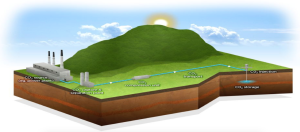Posted on January 4, 2022 by David M. Flannery
While there are certainly voices that are urging that net-zero CO2 emissions can be achieved without reliance on fossil fuels, the recent events with the electric power grid in Texas are causing many policy-makers to focus attention on modernization of the nation’s fossil fuel energy infrastructure with carbon capture utilization and sequestration (“CCUS”) technology. As Ernest Moniz, former Secretary of the U.S. Department of Energy (DOE) stated in his testimony on March 22, 2021, before the House Committee on Energy and Commerce (https://www.congress.gov/117/meeting/house/111362/witnesses/HHRG-117-IF00-Wstate-MonizE-20210322.pdf) configuring the electric power grid must be “matched to the mix of critical generation and storage technologies: variable renewables wind and solar, batteries and long duration storage, advanced nuclear technologies (fission and fusion), fossil power plants with carbon capture, utilization and sequestration (CCUS)”.
The path forward for the expansion of CCUS will require significant efforts on a variety of fronts, including financing, pipeline infrastructure, environmental protection, and environmental justice.
With respect to financing and infrastructure, there have been significant new developments in recent weeks including DOE’s selection of 12 CCS projects (https://netl.doe.gov/sites/default/files/publication/NETL-November-2021-Carbon-Capture-Newsletter.pdf) and the President’s action to sign into law the Infrastructure Investment and Jobs Act, Title III, Subtitle A, (https://www.govtrack.us/congress/bills/117/hr3684/text) which provides grant funds for CCUS infrastructure. The legislation finds that large-scale deployment of carbon capture, removal, utilization, transport, and storage is critical for achieving mid-century climate goals.
Additionally, there is new activity at the state environmental permitting level with the states of Arizona, Louisiana and West Virginia seeking to join North Dakota and Wyoming to obtain U.S. Environmental Protection Agency delegation of the Class VI UIC Program under 40 CFR Part 146, Subpart H related to the underground injection of CO2 (https://www.epa.gov/uic/primary-enforcement-authority-underground-injection-control-program#what_states).
Finally, it is important to note that on June 30, 2021, the White House Council on Environmental Quality submitted its Report to Congress on Carbon Capture, Utilization, and Sequestration (https://www.whitehouse.gov/wp-content/uploads/2021/06/CEQ-CCUS-Permitting-Report.pdf) which states that to reach the goal of net-zero emissions by 2050, “the United States will likely have to capture, transport, and permanently sequester significant quantities of carbon dioxide.” The report also offered several significant recommendations including the caution that “[r]esponsible CCUS projects should address cumulative pollution and should incorporate environmental justice and equity considerations.”
There is no doubt that implementation of CCUS at a national level will present significant challenges. A successful outcome, however, will provide the nation with a path forward to meet its climate goals, while assuring the viability of the nation’s electric grid.

